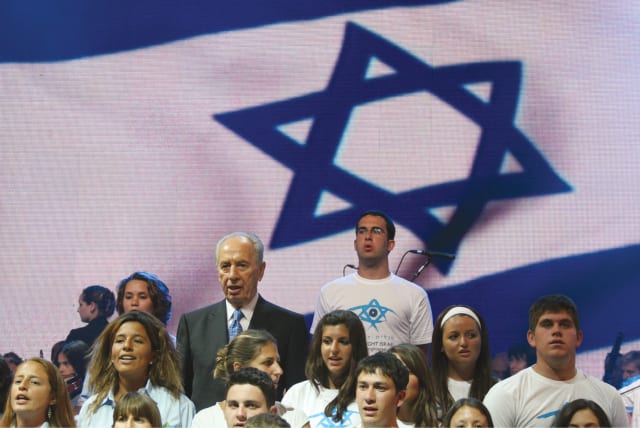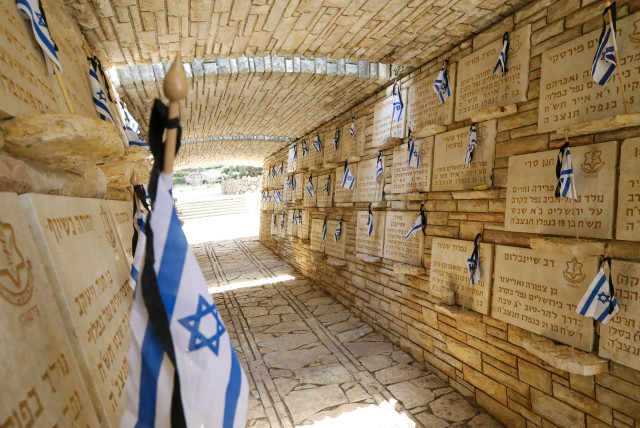‘Hatikvah’: Hope and faith – why olim come to Israel - opinion

As I listened to “Hatikvah” over and over again, I reminded myself of why I had come to this country in the first place as a still-young entering unknown, uncharted territory.
The confluence of Yom Hazikaron (Remembrance Day for the Fallen of Israel’s Wars and Victims of Terrorism) and Yom Ha’atzma’ut (Independence Day) – the middle two “Days” sandwiched between Holocaust Remembrance Day and Jerusalem Day – represents an emotional challenge for even the hardened Israeli veteran, let alone new olim. Add to that all those who have lost a loved one, either to war or terrorism, and the mountain is all the more difficult to climb.
Even more than two decades after the murder of our son by Hamas terrorists, my wife and I find ourselves dizzy and drained after touching the lowest lows and highest highs of the previous week.
Words alone fail to fully capture our feelings. How can you describe what it is like to bury a child? Where can you store the glowing memories of years gone by and the lost aspirations of the years to come? How can we balance the loss of a limb on the family tree, while at the same time embrace this brave new world of Israel that we have chosen to make our own?
Words alone cannot do it justice, but words set to music – song – can strike a deeper chord. Music can reach your soul and connect to you in a transcendent, pervasive way that is well beyond the lyrics. Music not only creates the mood; it haunts and it heals at the very same time.
Three particular songs were the soundtrack of our journey this year.
The ceremony in Ra’anana on the night of Remembrance Day is always stunning and spectacular in its pageantry and power. This year’s event focused on the trauma of the Yom Kippur War, a stunning, sobering watershed event in Israeli history. After miraculous victories in 1948 and 1967, the surprise attack that claimed more than 2,500 young lives starkly reminded us that we are fallible after all, that peace is eternally elusive. Featured as background to the dramatic scenes of battle was Naomi Shemer’s haunting ballad “Lu Yehi”; patterned after The Beatles’ “Let It Be,” it expressed the pain and promise of the 1973 conflict.
There is still a white sail on the horizon, opposite a heavy black cloud. All that we ask for – may it be. Lu yehi, may it be; all that we seek, may it be.
During the transition ceremony that closes the somber Remembrance Day and introduces the celebratory Independence Day, the most fitting music was “Al Kol Eleh,” again brilliantly created by Naomi Shemer. Its lyrics express the deepest yearnings of every survivor:
Every bee that brings the honey needs a sting to be complete; and we all must learn to taste the bitter with the sweet. Don’t uproot what has been planted; so our bounty may increase; let our dearest wish be granted: Bring us peace, bring us peace. For the sake of all these things, oh Lord, let your mercy be complete; bless the sting and bless the honey; bless the bitter and the sweet.
"Hatikvah:" The song that followed us the most
But the song that followed us most diligently was, of course, “Hatikvah.” We heard it no less than four times during those 24 hours: on the eve of Remembrance Day; at the military cemetery in the morning; after the memorial prayer for the fallen; and at the conclusion of festive prayers marking Israel’s 75th birthday. The fourth time, I must regrettably say, was when overzealous and inconsiderate – in the extreme – protesters against the current government recited the words in a preplanned, pathetic attempt to drown out the featured speaker at the cemetery. That was truly the saddest “Hatikvah” I have ever had the displeasure of hearing.
“HATIKVAH” ITSELF has its own amazing history. It began as a nine-stanza Hebrew poem titled “Tikvatenu” (“Our Hope”), written by 19th-century Hebrew poet Naphtali Herz Imber, who hailed from Galicia. Inspired by the Hibbat Zion movement of early Zionism, Imber originally wrote the poem in 1878 while living in Romania, and published it in an 1886 collection of his poetry, Barkai (Morning Star), issued in Jerusalem. The melody was composed by a Romanian Jewish immigrant named Samuel Cohen, adapted from a Moldavian folk song, “Carul cu Boi” (Cart and Oxen). “Hatikvah” spread rapidly among Jewish pioneers as part of the new culture of secular Hebrew songs and folk dances that existed in the early decades of the Zionist movement. Imber would leave Palestine, live in London and Boston, before dying of alcoholism in abject poverty in New York’s Lower East Side in 1909.
Ironically, Theodor Herzl was not a fan of “Hatikvah” and looked for alternatives. Chief Rabbi Abraham Isaac Kook composed a parallel poem, “Ha’emuna” (“The Faith”), which speaks of the “steadfast faith in the return to our holy land... where we shall serve our God.” At the same time, socialist Zionists denounced the poem for its religious, messianic overtones, such as the reference to an ancient biblical promise of Jewish return.
Nevertheless, most Zionists embraced “Hatikvah.” For years, it was sung at the annual Zionist congresses and other political events around the world. In 1933, at the 18th Zionist Congress, the song was officially adopted as the movement’s anthem, together with the blue and white flag. In the 1940s, many Jews in Europe would defiantly sing “Hatikvah” as a gesture of collective hope and spiritual resistance in the face of the Nazi Holocaust and Stalinist terror.
Yet after the creation of the state in 1948, the Israeli government declined to recognize “Hatikvah” as the official state anthem, despite adopting a new flag and coat of arms as national symbols. Still, “Hatikvah” was openly promoted as the de facto national anthem and used at all official state occasions. Only in November 2004, over a century after its composition, was “Hatikvah” officially designated our national anthem by the Knesset, bringing its journey full circle.
As I listened to “Hatikvah” over and over again, I reminded myself of why I had come to this country in the first place as a still-young man in the midst of a career, entering unknown, uncharted territory to make a new start and do my small share to further Jewish history in the one and only place where it will be shaped and decided.
It was because of Tikva and Emuna, Hope and Faith; hope that we will solidify our claim over our eternal homeland and end our ceaseless wandering across the planet, and faith that this generation will be the one to finally greet the final redemption of the Jewish people.
The writer is director of the Jewish Outreach Center of Ra’anana.
jocmtv@netvision.net.il
Jerusalem Post Store
`; document.getElementById("linkPremium").innerHTML = cont; var divWithLink = document.getElementById("premium-link"); if (divWithLink !== null && divWithLink !== 'undefined') { divWithLink.style.border = "solid 1px #cb0f3e"; divWithLink.style.textAlign = "center"; divWithLink.style.marginBottom = "15px"; divWithLink.style.marginTop = "15px"; divWithLink.style.width = "100%"; divWithLink.style.backgroundColor = "#122952"; divWithLink.style.color = "#ffffff"; divWithLink.style.lineHeight = "1.5"; } } (function (v, i) { });

